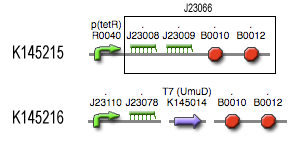Team:KULeuven/Project/Filter
From 2008.igem.org
m |
m |
||
| Line 1: | Line 1: | ||
| - | {{:Team:KULeuven/Tools/ | + | {{:Team:KULeuven/Tools/Header}} |
| + | |||
<div style="float: right;">[[Image:pictogram_filter.png|70px]]</div> | <div style="float: right;">[[Image:pictogram_filter.png|70px]]</div> | ||
Revision as of 14:32, 30 July 2008
Filter
The filter mechanism makes use of a coherent feedforward loop with and gate (reference). For this system, we thus needed a primary messenger, which gives a signal that leads to a secondary messenger, and that is fast degrading. The secondary messenger is a signal that is more stable in time. They cooperate together in the AND-gate to result in another signal. This last signal is the output of the filter.
Among the fast degrading molecules in a bacterial cell are mRNA's. We used the key-lock system as a primary messenger. Upon input signal, BBa_J23009 is transcribed and RiboKey3d is produced. This mRNA has a relatively short lifetime (referentie naar parameters van de ir's). This key can unlock the RiboLock3d, which is part BBa_J23032.
Under the constitutive promoter BBa_I23110, and locked by RiboLock3d, we find BBa_K145xxx, a T7 RNA polymerase with UmuD-derived tag. This T7 RNA polymerase is a protein, and thus much more stable than mRNA. So stable, that modeling proved it was too stable. So a tag has been added to make it degrade faster. A C-terminal LVA tag would probably not have worked, as the C-terminal of T7 RNA polymerase is part of the catalytic region (figuur). An N-terminal tag, however, is the solution to this problem. More information on this N-terminal, UmuD derived tag can be found here (link).
We see now, that production of the RiboLock3d will give rise to T7 RNA polymerase production, and that the requirements concerning the lifetime of the messenger molecules are fulfilled. The T7 promoter and RiboLock3d together now form the AND-gate, giving transcription only when both the T7 RNA polymerase and RiboLock3d are present together.
For more information on the exact kinetics and dynamics of this system, see the modeling page (link).
 "
"


